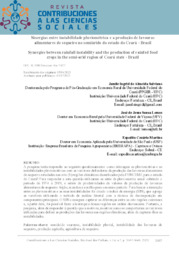Sinergias entre instabilidade pluviométrica e a produção de lavouras alimentares de sequeiro no Semiárido do estado do Ceará-Brasil.
Sinergias entre instabilidade pluviométrica e a produção de lavouras alimentares de sequeiro no Semiárido do estado do Ceará-Brasil.
Author(s): SALVIANO, J. I. de A.; LEMOS, J. de J. S.; MARTINS, E. C.
Summary: Resumo: A pesquisa tenta responder ao seguinte questionamento: como interagem as pluviometrias e as instabilidades pluviométricas com as variáveis definidoras da produção das lavouras alimentares de sequeiro estudadas nas oito (8) regiões climáticas classificadas pela FUNCEME para o estado do Ceará? Para responder a esta questão utilizaram-se série de pluviometria anual cobrindo o período de 1974 a 2019, e séries de produtividades de valores da produção de lavouras alimentares de sequeiro: feijão, mandioca e milho para o mesmo período. Para buscar a interação entre as pluviometrias e as suas instabilidades foi criado o índice de sinergia (SIN), que agrega as variáveis utilizando o método de análise fatorial com a técnica de decomposição em componentes principais. O SIN conseguiu capturar as diferenças entre as oito regiões cearenses e, a partir dele, foi possível fazer a hierarquia dessas regiões em ordem decrescente. Portanto, a pesquisa, além de responder à questão que a motivou, mostrou como se comportaram as variáveis utilizadas para definir as produções das lavouras nas regiões climáticas, além de capturar-lhes as instabilidades.Palavras-chave:semiárido cearense,instabilidade pluvial,instabilidade das lavouras de sequeiro,produção agrícola,agricultura de sequeiro. Abstract: The research tries to answer the following question: how do rainfall and rainfall instabilities interact with the defining variables of the production of rainfed food crops studied in the eight (8) climatic regions classified by FUNCEME for the state of Ceará? To answer this question we used series of annual rainfall covering the period 1974 to 2019, and series of productivity values of the production of rainfed food crops: beans, cassava and corn for the same period. To seek the interaction between the rainfall and their instabilities the synergy index (SIN) was created that aggregates the variables using the factor analysis method with the principal component decomposition technique. The SIN was able to capture the differences between the eight regions of Ceará and, from it was possible to make the hierarchy of these regions in descending order.Therefore, the research, besides answering the question that motivated it, showed how the variables used to define the crop yields in the climatic regions behaved, besides capturing the instabilities
Publication year: 2023
Types of publication: Journal article
Unit: Embrapa Goats & Sheep
Keywords: Agricultura de sequeiro, Agricultural products, Agriculture, Beans, Brasil, Brazil, Cassava, Ceará, Corn, Cultivo de Sequeiro, Dry farming, Food crops, Instabilidade pluvial, Instability of dryland crops, Lavouras de sequeiro, Pluvial instability, Produção Agrícola, Rainwater, Semiarid soils, Semiárido
Observation
Some of Embrapa's publications are published as ePub files. To read them, use or download one of the following free software options to your computer or mobile device. Android: Google Play Books; IOS: iBooks; Windows and Linux: Calibre.
Access other publications
Access the Agricultural Research Database (BDPA) to consult Embrapa's full library collection and records.
Visit Embrapa Bookstore to purchase books and other publications sold by Embrapa.

